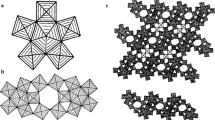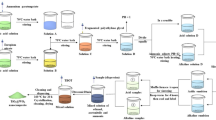Abstract
Synthesis and characterization of tungsten based mixed valence state nanoparticles and their novel applications are reviewed. The mixed valence state tungsten based homogeneous nanomaterials such as bronze structure MxWO3 (M = Na+, K+, Rb+, Cs+, NH4+, etc.) and tungsten sub-oxide W18O49 possess excellent infrared (IR) light shielding property, implying their great potential applications on heat ray shielding and indoor energy saving effect in summer season. Also, some novel properties such as electric conductivity, bio thermal therapy function and electrochromic properties of mixed valence state tungsten based materials are introduced. The design of components, formation of composites and structure control of thin films are expected to realize the property enhancement and candidates for practice application as window materials. The multifunctionality of the mixed valence state based composites also implies great potential on novel applications of various building materials.

Reproduced from Ref. [7] with permission from the American Institute of Physics


Reproduced from Ref. [23] with permission from RSC

Reproduced from Ref. [9] with permission from ACS

Reproduced from Ref. [36] with permission from RSC

Reproduced from Ref. [54] with permission from Elsevier

Similar content being viewed by others
Change history
21 August 2021
A Correction to this paper has been published: https://doi.org/10.1007/s42864-021-00115-4
References
Macisaac D, Kanner G, Anderson G. Basic physics of the incandescent lamp (lightbulb). Phys Teach. 1999;37(9):520.
Gaur RPS. Modern hydrometallurgical production methods for tungsten. JOM. 2006;58(9):45.
Liu BX, Shi AH, Su Q, Chen GJ, Li W, Zhang LN, Yang B. Recovery of tungsten carbides to prepare the ultrafine WC-Co composite powder by two-step reduction process. Powder Technol. 2017;306:113.
Barnaby CF, Borg MT. Emerging technologies and military doctrine: a political assessment. London: St. Martin’s Press Inc; 1986.
Bregel T, Krauss-Vogt W, Michal R, Saeger KE. On the application of W/Cu materials in the fields of power engineering and plasma technology. IEEE Trans Compo Hybrids Manuf Technol. 1991;14(1):8.
Simon A. Group 1 and 2 suboxides and subnitrides metals with atomic size holes and tunnels. Coord Chem Rev. 1997;163:253.
Migasa DB, Shaposhnikov VL, Borisenko VE. Tungsten oxides. II. The metallic nature of Magnéli phases. J Appl Phys. 2010;108(9):093714.
Wells AF. Structural inorganic chemistry. 5th ed. New York: Oxford University Press; 1984.
Guo CS, Yin S, Yan M, Kobayashi M, Kakihana M, Sato T. Morphology-controlled synthesis of W18O49 nanostructures and their near-infrared absorption properties. Inorg Chem. 2012;51(8):4763.
Guo CS, Yin S, Dong Q, Sato T. The near infrared absorption properties of W18O49. RSC Adv. 2012;2(12):5041.
Zhu YQ, Hu WB, Hsu WK, Terrones M, Grobert N, Hare JP, Kroto HW, Walton DRM, Terrones H. Tungsten oxide tree-like structures. Chem Phys Lett. 1999;309(5–6):327.
Li Y, Bando Y, Golberg D. Quasi-aligned single-crystalline W18O49 nanotubes and nanowires. Adv Mater. 2003;15(15):1294.
Yin S, Riapanitra A, Asakura Y. Nanomaterials for infrared shielding smart coatings. Funct Mater Lett. 2018;11(5):1830004.
Wang SJ, Chen CH, Ko RM, Kuo YC, Wong CH, Wu CH. Preparation of tungsten oxide nanowires from sputter-deposited WCx films using an annealing/oxidation process. Appl Phys Lett. 2005;86(26):263103.
Lee K, Seo WS, Park JT. Synthesis and optical properties of colloidal tungsten oxide nanorods. J Am Chem Soc. 2003;125(12):3408.
Liu BX, Wang JS, Wu JS, Li HY, Li ZF, Zhou ML, Zuo TY. Controlled fabrication of hierarchical WO3 hydrates with excellent adsorption performance. J Mater Chem A. 2014;2(6):1947
Rotaru A, Miller AJ, Arnold DC, Morrison FD. Towards novel multiferroic and magnetoelectric materials: dipole stability in tetragonal tungsten bronzes. Philos Trans R Soc A. 2014;372(2009):20120451.
Takeda H, Adachi K. Near infrared absorption of tungsten oxide nanoparticle dispersions. J Am Ceram Soc. 2007;90(12):4059.
Adachi K, Miratsu M, Asahi T. Absorption and scattering of near-infrared light by dispersed lanthanum hexaboride nanoparticles for solar control filters. J Mater Res. 2010;25(3):510.
Guo CS, Yin S, Zhang PL, Yan M, Adachi K, Chonan T, Sato T. Novel synthesis of homogenous CsxWO3 nanorods with excellent NIR shielding properties by a water controlled-release solvothermal process. J Mater Chem. 2010;20(38):8227.
Kaper H, Djerdj I, Gross S, Amenitsch H, Antoniettia M, Smarsly BM. Ionic liquid- and surfactant-controlled crystallization of WO3 films. Phys Chem Chem Phys. 2015;17(27):18138.
Guo CS, Yin S, Sato T. Effects of crystallization atmospheres on the near-infrared adsorption and electroconductive propeties of tungsten bronze type MxWO3 (M = Na, K). J Am Ceram Soc. 2012;95(5):1634.
Guo CS, Yin S, Yan M, Sato T. Facile synthesis of homogeneous CsxWO3 nanorods with excellent low-emissivity and NIR shielding property by a water controlled-release process. J Mater Chem. 2011;21(13):5099.
Huang XJ, Bao J, Han Y, Cui CW, Wang JX, Zeng XF, Chen JF. Controllable synthesis and evolution mechanism of tungsten bronze nanocrystals with excellent optical performance for energy-saving glass. J Mater Chem A. 2018;6(29):7783.
Lassner E, Schubert WD. Tungsten: properties, chemistry, technology of the element, alloys, and chemical compounds. New York: Kluwer Academic Publisher; 1999.
Guo CS, Yin S, Sato T. Synthesis of one-dimensional hexagonal sodium tungsten oxide and its near-infrared shielding property. Nanosci Nanotechnol Lett. 2011;3(3):413.
Sheng T, Chavvakula PP, Cao BB, Yue NL, Zhang Y, Zhang HT. Growth of ultra-long sodium tungsten oxide and tungsten oxide nanowires: effects of impurity and residue deposition. J Cryst Growth. 2014;395:61.
Guo CS, Yin S, Dong Q, Sato T. Simple route to (NH4)xWO3 nanorods for near infrared absorption. Nanoscale. 2012;4:3394.
Guo CS, Yin S, Dong Q, Kimura T, Tanaka M, Hang LT, Wu XY, Sato T. Solvothermal fabrication of rubidium tungsten bronze for the absorption of near infrared light. J Nanosci Nanotechnol. 2013;13(5):3236.
Andreev AA, Mak AA, Solovyev NA. An introduction to hot laser plasma physics. New York: Nova Science Publishers; 2000.
Stover JC. Optical scattering: measurement analysis. 3rd ed. Washington: SPIE Optical Engineering Press; 1995.
Liu JX, Ando Y, Dong XL, Shi F, Yin S, Adachi K, Chonan T, Tanaka A, Sato T. Microstructure and electrical-optical properties of cesium tungsten oxides synthesized by solvothermal reaction followed by ammonia annealing. J Solid State Chem. 2010;183(10):2456.
White RP. Infrared deicing system for aircraft. US Patent 6092765;2000.
Tanaka F, Verboven P, Scheerlinck N, Morita K, Iwasaki K, Nicola B. Investigation of far infrared radiation heating as an alternative technique for surface decontamination of strawberry. J Food Eng. 2007;79(2):445.
Tang HB, Su YC, Hu T, Liu SD, Mu SJ, Xiao LH. Synergetic effect of LaB6 and ITO nanoparticles on optical properties and thermal stability of poly(vinylbutyral) nanocomposite films. Appl Phys A. 2014;117(4):2127.
Guo CS, Yin S, Yu HJ, Liu S, Dong Q, Goto T, Zhang Z, Li Y, Sato T. Photothermal ablation cancer therapy using homogeneous CsxWO3 nanorods with broad near-infrared absorption. Nanoscale. 2013;5(14):6469.
Yin S. Creation of advanced optical responsive functionality of ceramics by green processes. J Ceram Soc Jpn. 2015;123(1441):823.
Ragnarsdóttir KV. Rare metals getting rarer. Nat Geosci. 2008;1(11):720.
Sasaki T, Endo Y, Nakaya M, Kanie K, Nagatomi A, Tanoue K, Nakamura R, Muramatsu A. One-step solvothermal synthesis of cubic-shaped ITO nanoparticles precisely controlled in size and shape and their electrical resistivity. J Mater Chem. 2010;20(37):8153.
Habash RWY, Bansal R, Krewski D, Alhafid HT. Thermal therapy, part 1: an introduction to thermal therapy. Crit Rev Biomed Eng. 2006;34(6):459.
Habash RWY, Bansal R, Krewski D, Alhafid HT. Thermal therapy, part 2: hyperthermia techniques. Crit Rev Biomed Eng. 2006;34(6):491.
Hu KW, Liu TM, Chung KY, Huang KS, Hsieh CT, Sun CK, Yeh CS. Efficient near-IR hyperthermia and intense nonlinear optical imaging contrast on the gold nanorod-in-shell nanostructures. J Am Chem Soc. 2009;131(40):14186.
Jang B, Park JY, Tung CH, Kim IH, Choi Y. Gold nanorod-photosensitizer complex for near-infrared fluorescence imaging and photodynamic/photothermal therapy in vivo. ACS Nano. 2011;5(2):1086.
Huang HC, Rege K, Heys JJ. Spatiotemporal temperature distribution and cancer cell death in response to extracellular hyperthermia induced by gold nanorods. ACS Nano. 2010;4(5):2892.
Zhang ZJ, Wang LM, Wang J, Jiang XM, Li XH, Hu ZJ, Ji YH, Wu XC, Chen CY. Mesoporous silica-coated gold nanorods as a light-mediated multifunctional theranostic platform for cancer treatment. Adv Mater. 2012;24(11):1418.
Gao L, Fei JB, Zhao J, Li H, Cui Y, Li JB. Hypocrellin-loaded gold nanocages with high two-photon efficiency for photothermal/photodynamic cancer therapy in vitro. ACS Nano. 2012;6(9):8030.
Xia YN, Li WY, Cobley CM, Chen JY, Xia XH, Zhang Q, Yang MX, Cho EC, Brown PK. Gold nanocages: from synthesis to theranostic applications. Acc Chem Res. 2011;44(10):914.
Liu GX, Wang SN, Nie YT, Sun XH, Zhang YH, Tang Y. Electrostatic-induced synthesis of tungsten bronze nanostructures with excellent photo-to-thermal conversion behavior. J Mater Chem A. 2013;1(35):1020.
Chen CJ, Chen DH. Preparation and near-infrared photothermal conversion property of cesium tungsten oxide nanoparticles. Nanoscale Res Lett. 2013;8:57.
Tian G, Zhang X, Zheng XP, Yin WY, Ruan LF, Liu XD, Zhou LJ, Yan L, Li SJ, Gu ZJ, Zhao YL. Multifunctional RbxWO3 nanorods for simultaneous combined chemo-photothermal therapy and photoacoustic/CT imaging. Small. 2014;10(20):4060.
Zhang YX, Li B, Cao YJ, Qin JB, Peng ZY, Xiao ZY, Huang XJ, Zou RJ, Hu JQ. Na0.3WO3 nanorods: a multifunctional agent for in vivo dual-model imaging and photothermal therapy of cancer cells. Dalton Trans. 2015;44(6):2771.
Guo CS, Yu HJ, Feng B, Gao WD, Yan M, Zhang ZW, Li YP, Liu SQ. Highly efficient ablation of metastatic breast cancer using ammonium-tungsten-bronze nanocube as a novel. Biomaterials. 2015;52:407.
Cai LG, Wu XM, Gao Q, Fan YM. Effect of morphology on the near infrared shielding property and thermal performance of K0.3WO3 blue pigments for smart window applications. Dyes Pigment. 2018;156:33.
Zheng BH, Han Z, Wu G, Liu YF, Liu CT, Ma FW. Synthesis of near infrared-activatable KxWO3 nanorods for photothermal therapy. Mater Lett. 2018;212:194.
Sbar NL, Podbelski L, Yang HM, Pease B. Electrochromic dynamic windows for office buildings. Int J Sustain Built Environ. 2012;1(1):125.
Runnerstrom EL, Llordés A, Lounis SD, Milliron DJ. Nanostructured electrochromic smart windows: traditional materials and NIR-selective plasmonic nanocrystals. Chem Commun. 2014;50(73):10555.
Xue B, Peng J, Xin ZF, Kong YM, Li L, Li B. High-contrast electrochromic multilayer films of molybdenum-doped hexagonal tungsten bronze (Mo0.05-HTB). J Mater Chem. 2005;15(45):4793.
Rattanakam R, Supothina S. Hydrothermal synthesis and electrochromic properties of potassium tungsten oxide nanorods. J Nanosci Nanotech. 2011;11(10):8974.
Moshofsky B, Mokari T. Electrochromic active layers from ultrathin nanowires of tungsten oxide. J Mater Chem C. 2014;2(18):3556.
Cai GF, Wang JX, Lee PS. Next-generation multifunctional electrochromic devices. Acc Chem Res. 2016;49(8):1469.
Wu X, Yin S, Dong Q, Liu B, Sato T. Photocatalytic performance and near infrared absorption property of tungsten and tungsten–carbon doped titania. Mater Technol: Adv Funct Mater. 2014;29(A1):A20.
Wu XY, Yin S, Xue DF, Komarneni S, Sato T. CsxWO3/ZnO nanocomposite as a smart coating for photocatalytic environmental cleanup and heat insulation. Nanoscale. 2015;7(40):17048.
Wu XY, Wang JT, Zhang GK, Katsumata K, Yanagisawa, Sato T, Yin S. Series of MxWO3/ZnO (M = K, Rb, NH4) nanocomposites: combination of energy saving and environmental decontamination functions. Appl Catal B. 2017;201:128.
Liu TY, Liu B, Wang J, Yang LF, Ma XL, Li H, Zhang YH, Yin S, Sato T, Sekino T, Wang YH. Smart window coating based on F-TiO2-KxWO3 nanocomposites with heat shielding, ultraviolet isolating, hydrophilic and photocatalytic performance. Sci Rep. 2016;6:27373.
Yang LF, Liu B, Liu TY, Ma XL, Li H, Yin S, Sato T, Wang YH. A P25/(NH4)xWO3 hybrid photocatalyst with broad spectrum photocatalytic properties under UV, visible, and near-infrared irradiation. Sci Rep. 2017;7:45715.
Shi AY, Li HY, Yin S, Zhang JC, Wang YH. H2 evolution over g-C3N4/CsxWO3 under NIR light. Appl Catal B. 2018;228:75.
Acknowledgements
This research was partly supported by Japan Society for the Promotion of Science KAKENHI (Grant Number JP16H06439, Grant-in-Aid for Scientific Research on Innovative Areas), the Dynamic Alliance for Open Innovations Bridging Human, Environment and Materials, the Cooperative Research Program of Network Joint Research Center for Materials and Devices and the Hosokawa Powder Technology Foundation.
Author information
Authors and Affiliations
Corresponding author
Additional information
Publisher's Note
Springer Nature remains neutral with regard to jurisdictional claims in published maps and institutional affiliations.
Rights and permissions
About this article
Cite this article
Yin, S., Asakura, Y. Recent research progress on mixed valence state tungsten based materials. Tungsten 1, 5–18 (2019). https://doi.org/10.1007/s42864-019-00001-0
Received:
Revised:
Accepted:
Published:
Issue Date:
DOI: https://doi.org/10.1007/s42864-019-00001-0








